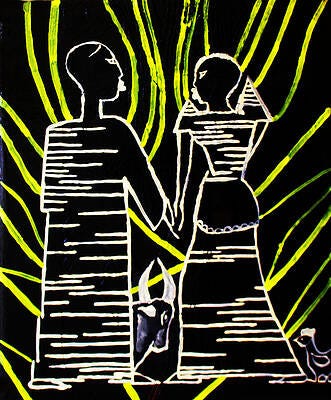Dear Friends,
What can I say? An apology seems out of place. With everything going on in the world, I doubt a late newsletter is that big a deal. So I will say thank you. For being around. For your continued interest and support. For making MA one of the places you visit to find inspiration and, hopefully, joy in this increasingly chaotic world.
In October, we continued our exploration of important women in the creation myths and foundation legends of African peoples. We met Arraweelo, Nambi, Tenemba, Massassi and Morongo. All of them are complex women whose stories, to me, provide a foundation for embracing the multiplicities that are available as a Black African woman.
A woman crowned holy is a calamity worth repeating. — Sarah Ghazal Ali
My breath caught when I read these words from Sarah Ghazal Ali’s My Faith Gets Grime under Its Nails. To study women from African mythology and folklore, is to sink your fingers into the fertile earth from which all life springs and glory in the rich potential of their stories. It is an excavation of archetypes of African womanhood through which the modern African woman and all women might better understand themselves. It is not a comfortable journey – one has to reckon with ALL the archetypes of womanhood (even the unlikable ones), and how they manifest in our lives. But it is one I remain grateful for the privilege to be able to go on.

As important as their stories are, even more important is how their lives can help us make sense of our own lives. A couple of months ago, I found myself reflecting on what I have learned so far from all the female figures I have encountered in African mythology and folklore. A few things that came to mind:
An awareness of womanhood that can stand on its own and stand its ground.
A better appreciation for and trust in my ability to see, to create, and to connect.
A vision of community that doesn’t restrict women and that isn’t founded on unreasonable hierarchies.
A better appreciation of my sexuality.
Strength to face destruction, humiliation, defamation, ruin and still hold my head high and keep on being and becoming.
The capacity to exercise my prerogative whatever that looks like.
All the faces of compassion.
Having read so many books like Wild Mercy, Women who run with Wolves, or If Women Rose Rooted, or The Heroine’s Journey, it bothers me that there are not enough books which explore the intersection of feminine psychology, mysticism, and mythological/folkloric archetypes but with a focus on African mythological figures. However, this is a book I might be able to write given enough time and resources so… putting it out there!
What to Expect from MA in November
Random Bits of Folklore. I don’t have any particular theme I want to explore for podcast episodes so we’ll rummage around the bag and go with what comes up.
The final installation of this year’s MA Quarterly Essay which investigates the symbolism of neck rings in African ornamental culture (which we missed last month).
More about my upcoming book “The Watkins Book of African Folklore”.
Meanwhile, if you have an interest in Old English and want to read what will be a great story, please check out and consider ordering Ōsweald Bera by my friend and linguistic scholar, Colin Gorrie. Ōsweald Bera is a language textbook that teaches you Old English (hello!) and a story about a very curious bear and his friends and adventures in medieval England.
Thank you, as always and again, for being here.
Be well,
Helen



